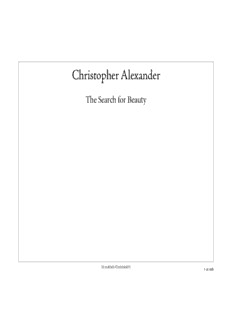
Christopher Alexander PDF
Preview Christopher Alexander
Christopher Alexander The Search for Beauty STANFORD UNIVERSITY 1 of 165 Patterns • Patterns and pattern languages for software • Pattern Languages of Programs • Hillside Group • “Pattern Languages of Program Design” (Coplien and Schmidt) STANFORD UNIVERSITY 2 of 165 Christopher Alexander • Notes on the Synthesis of Form, 1964 • The Oregon Experiment, 1975 • A Pattern Language, 1977 • The Timeless Way of Building, 1979 • The Production of Houses, 1985 • A New Theory of Urban Design, 1987 • A Foreshadowing of 21st Century Art: The Color and Geometry of Very Early Turkish Carpets, 1993 • The Nature of Order, 199x STANFORD UNIVERSITY 3 of 165 Fact and Value th th • Mind and matter separated by philosophy and science in the 17 and 18 centuries • Descartes • Science searched for what was, not for what made things beautiful • Contingency—a thing is beautiful to some observer STANFORD UNIVERSITY 4 of 165 Fact and Value Myself, as some of you know, originally a mathematician, I spent several years, in the early sixties, trying to define a view of design, allied with science, in which values were also let in by the back door. I too played with operations research, linear programming, all the fascinating toys, which ff mathematics and science have to o er us, and tried to see how these things can give us a new view of design, what to design, and how to design. Finally, however, I recognized that this view is essentially not productive, and that for mathematical and scientific reasons, if you like, it was essential to find a theory in which value and fact are one, in which we recognize that here is a central value, approachable through feeling, and approachable by loss of self, which is deeply connected to facts, and forms a single indivisible world picture, within which productive results can be obtained. STANFORD UNIVERSITY 5 of 165 The Timeless Way of Building There is one timeless way of building. It is thousands of years old, and the same today as it has always been. The great traditional buildings of the past, the villages and tents and temples in which man feels at home, have always been made by people who were very close to the center of this way. It is not possible to make great buildings, or great towns, beautiful places, places where you feel yourself, places where you feel alive, except by following this way. And, as you will see, this way will lead anyone who looks for it to buildings which are themselves as ancient in their form, as the trees and hills, and as our faces are. STANFORD UNIVERSITY 6 of 165 The Quality To seek the timeless way we must first know the quality without a name. There is a central quality which is the root criterion of life and spirit in a man, a town, a building, or a wilderness. This quality is objective and precise, but it cannot be named. STANFORD UNIVERSITY 7 of 165 The Gate To reach the quality without a name we must then build a living pattern language as a gate. This quality in buildings and in towns cannot be made, but only generated, indirectly, by the ordinary actions of the people, just as a flower cannot be made, but only generated from the seed. The people can shape buildings for themselves, and have done it for centuries, by using languages I call pattern languages. A pattern language gives each person who uses it the power to create an infinite variety of new and unique buildings, just as his ordinary language gives him the power to create an infinite variety of sentences. STANFORD UNIVERSITY 8 of 165 The Way Once we have built the gate, we can pass through it to the practice of the timeless way. Now we shall begin to see in detail how the rich and complex order of a town can grow from thousands of creative acts. For once we have a common pattern language in our town, we shall all have the power to make our streets and buildings live, through our most ordinary acts. The language, like a seed, is the genetic system which gives our millions of small acts the power to form a whole. STANFORD UNIVERSITY 9 of 165 The Quality I was no longer willing to start looking at any pattern unless it presented itself to me as having the capacity to connect up with some part of this quality [the quality without a name]. Unless a particular pattern actually was capable of generating the kind of life and spirit that we are now discussing, and that it had this quality itself, my tendency was to dismiss it, even though we explored many, many patterns. STANFORD UNIVERSITY 10 of 165
Description: